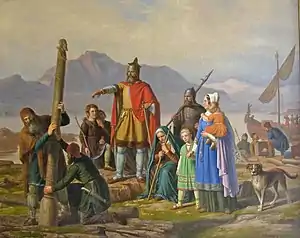Ingólfr Arnarson
Ingólfr Arnarson[lower-alpha 1] (in some sources named Bjǫrnólfsson) is commonly recognized as the first permanent Norse settler of Iceland, together with his wife Hallveig Fróðadóttir and brother Hjörleifr Hróðmarsson. According to tradition, they founded Reykjavík in 874.[1][2]


.jpg.webp)
Biography
Ingólfr Arnarson was from the small village of Rivedal at Sunnfjord in Sogn og Fjordane, Norway. According to the Icelandic Book of Settlements (Landnáma), he built his homestead in and gave name to Reykjavík in 874. However, archaeological finds in Iceland suggest settlement may have started somewhat earlier. The medieval chronicler Ari Þorgilsson said Ingólfr was the first Nordic settler in Iceland, but mentioned that Irish monks and hermits (Papar) had been in the country before the Norsemen. He wrote that they left because they did not want to live among the newly arrived Norse pagans.[3]
Landnáma (written two to three centuries after the settlement) contains a story about Ingólfr's settlement. The book claims he left Norway after becoming involved in a blood feud. He had heard about a new island which Garðar Svavarsson, Hrafna-Flóki Vilgerðarson and others had found in the Atlantic Ocean. With his step-brother Hjörleifr Hróðmarsson, he sailed for Iceland. When land was in sight, he threw his high seat pillars overboard and promised to settle where the gods decided to bring them ashore. Two of his slaves then searched the coasts for three years before finding the pillars in the small bay which eventually became the site of Reykjavík .[4]
In the meantime, Hjörleifr had been murdered by his Irish slaves because of his ill-treatment of them. Ingólfr hunted them down and killed them in the Westman Islands (Vestmannaeyjar). The islands got their name from that event, but west men (vestmenn) is a name that Norse men at this time sometimes used for Irishmen. Ingólfr was said to have settled a large part of southwestern Iceland, although after his settlement nothing more was known of him. His son, Torstein (Þorsteinn Ingólfsson), was a major chieftain and was said to have founded the first thing, or parliament, in Iceland. It was a forerunner of the Althingi.[5]
Legacy

In 1924, a statue of Ingólfr Arnarson, designed by Icelandic sculptor Einar Jónsson (1874–1954), was erected in Reykjavík. A copy of Einar Jónsson's statue of Ingolf Arnarsson from 1907 was erected in 1961 at Rivedal.[6]
See also
Notes
- In Modern Icelandic: Ingólfur Arnarson; modern Icelandic pronunciation: [ˈiŋkoulvʏr̥ ˈartnar̥sɔn].
In Modern Norwegian the first name is spelled either Ingolf or Ingolv; patronym variously as Arnarson, Arnarsson, Arneson, Arnesson or Ørnsson.
References
- "Ingólfur Arnarson - The First Icelander". sagamuseum.is. Retrieved January 20, 2016.
- "Ingólfr Arnarson Bjǫrnólfsson Ingolv Ørnsson". nbl.snl.no. Norsk biografisk leksikon. 29 September 2014. Retrieved 3 June 2019.
- "Ingolfr Arnarson". nrk.no. Retrieved January 20, 2016.
- Jon Gunnar Jørgensen. "Ingólfr Arnarson Bjǫrnólfsson Ingolv Ørnss". Norsk biografisk leksikon. Retrieved January 20, 2016.
- "Ingólfr Arnarson". Store norske leksikon. Retrieved January 20, 2016.
- "Statue of Ingolfur Arnarson (Reykjavik, Iceland)". International Travel News. Retrieved November 1, 2019.